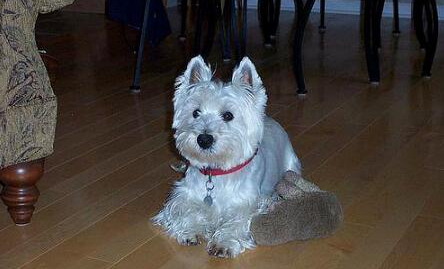这篇文章主要介绍在keras中对单一图像进行预测并返回预测结果的案例,文中介绍的非常详细,具有一定的参考价值,感兴趣的小伙伴们一定要看完!
模型经过训练测试之后,我们往往用一两张图对模型预测结果进行分析讨论,那么下面介绍在keras中用已训练的模型经过测试的方法。
下面是以利用预训练的ResNet来展示预测的效果,选了一张狗的图片,是来自一个kaggle比赛的。
预测结果第一个是一种苏格兰品种的狗,我也不知道准不准 == 。

import numpy as np
from keras.applications.imagenet_utils import decode_predictions
from keras.preprocessing import image
from keras.applications import *
import os
# 忽略硬件加速的警告信息
os.environ['TF_CPP_MIN_LOG_LEVEL'] = '2'
file_path = 'images/0a70f64352edfef4c82c22015f0e3a20.jpg'
img = image.load_img(file_path, target_size=(224, 224))
x = image.img_to_array(img)
x = np.expand_dims(x, axis=0)
model = ResNet50(weights='imagenet')
y = model.predict(x)
# print(np.argmax(y))
print('Predicted:', decode_predictions(y, top=3)[0])讲几点:
1.输入img转成numpy数组,shape处理成(224,224,3)一般来讲,对于预训练模型是有一个最小的尺寸值,比最小尺寸大就可以了。在ResNet中,尺寸最小大于等于197即可。
2.要对输入shape扩维变成(None,224,224,3),第一个None是batches,模型并不知道你输入的batches是多少,但是维度必须和ResNet的输入要一致。
3.虽然用的是ResNet,自己设计的模型也一个道理,保留一下训练的权重,把model模块和预测模块分开写,这个时候load一下权重,再预测即可。
补充知识:keras:怎样使用 fit_generator 来训练多个不同类型的输出
这个例子非常简单明了,模型由1个输入,2个输出,两个输出的分支分别使用MSE作为损失。
x = Convolution2D(8, 5, 5, subsample=(1, 1))(image_input)
x = Activation('relu')(x)
x = Flatten()(x)
x = Dense(50, W_regularizer=l2(0.0001))(x)
x = Activation('relu')(x)
output1 = Dense(1, activation='linear', name='output1')(x)
output2 = Dense(1, activation='linear', name='output2')(x)
model = Model(input=image_input, output=[output1, output2])
model.compile(optimizer='adam', loss={'output1': 'mean_squared_error', 'output2': 'mean_squared_error'})产生训练数据的生成器,这里y=[y1,y2].
batch_generator(x, y, batch_size):
....transform images
....generate batch batch of size: batch_size
yield(X_batch, {'output1': y1, 'output2': y2} ))之后,调用fit_generator
model.fit_generator(batch_generator(X_train, y_train, batch_size))
以上是在keras中对单一图像进行预测并返回预测结果的案例的所有内容,感谢各位的阅读!希望分享的内容对大家有帮助,更多相关知识,欢迎关注亿速云行业资讯频道!
亿速云「云服务器」,即开即用、新一代英特尔至强铂金CPU、三副本存储NVMe SSD云盘,价格低至29元/月。点击查看>>
免责声明:本站发布的内容(图片、视频和文字)以原创、转载和分享为主,文章观点不代表本网站立场,如果涉及侵权请联系站长邮箱:is@yisu.com进行举报,并提供相关证据,一经查实,将立刻删除涉嫌侵权内容。